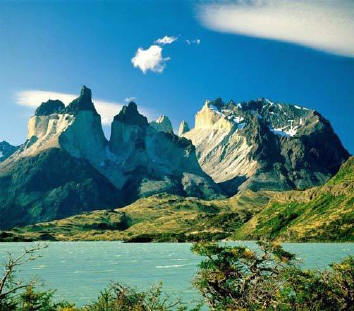|
||||||
|
Attractions
Santiago Sprawling outwards and sky-scrapering upwards, Chile's capital, Santiago, is immense. Its central core, however, is manageable and relatively small - a roughly triangular area bounded by the Rio Mapocho on the north. It is a city of grand thoroughfares and plazas, lined with public buildings and churches and circled by parks. The grid town plan imposed by the Spanish, however, is conducive to traffic jams and pollution. The Virgin Mary guards the city from the peak of the 860m (2821ft) Cerro San Cristóbal, part of the Parque Metropolitano recreational area.
The city's attractions include the colorful Mercado Central, the historical center of Plaza de Armas, the pedestrian mall of Paseo Ahumada (haunt of buskers and peddlers) and the late-colonial and block-filling Palacio de La Moneda - former mint, presidential residence and the site of Allende's last stand. |
|
|
Santiago has plenty of museums, including the beautifully arranged Pre-Colombian Museum and the Museo de Santiago, which documents the city's present sprawl with dioramas and reconstructions. The Palacio de Bellas Artes is modeled on the Petit Palais in Paris and has a fine collection of European and Chilean art.
Santiago's main budget hotel area is the seedy section of town near the Terminal de Buses Norte. Moderate and top-end hotels can be found in the central area bounded by Avenida Balmaceda and Avenida General O'Higgins (popularly known as the Alameda). Restaurants, from fast to flash, are in abundance, especially around the bus terminals, pedestrian malls, Alameda and Plaza de Armas. Bellavista, known as the 'Paris quarter', is one of the city's liveliest areas, with countless ethnic eateries and an active crafts fair on Friday and Saturday evenings.
Valparaíso Lying 120km (74mi) northwest of Santiago, Valpo is Chile's principal port and second-largest city. Despite its size, it is Chile's most distinctive city and one of South America's most intriguing. Occupying a narrow strip of land between the waterfront and the nearby hills, its convoluted center has distinctive, sinuous cobbled streets, and is overlooked by precipitous cliffs and hilltop suburbs which are accessed by funicular railways and stairway footpaths. It truly is a rabbit-warren of a place, which probably only a lifetime resident could completely fathom. It is conducive to maze-like strolls and rides on the funicular, and its natural history, fine arts and maritime museums are justly famed. Muelle Prat, the recently redeveloped pier, is a lively market area.
Viña del Mar Chile's premier beach resort is only 10km (6mi) north of Valparaíso, and is popularly known as the Garden City because of its manicured subtropical landscape of palm and banana trees. Horse-drawn carriages trot past attractive turn-of-the-century mansions on both river and beach frontages. Other attractions are the white-sand beaches, numerous parks and notable museums housed in restored mansions. The town is also the home of Chile's national botanical garden, comprising 61 hectares (151 acres) of native and exotic plants.
La Serena Important both historically and economically, the beachside city of La Serena is one of Chile's oldest post-Columbian cities. The region's silver, copper and agriculture were so important that the city had its own mint. Today, La Serena maintains a colonial air, although it is threatening Viña del Mar's supremacy as the premier beach resort. Apart from a string of beautiful beaches, attractions include a handful of museums and a number of nearby quaint villages and vineyards.
Parque Nacional Puyehue Situated in the beautiful Lake District, this is Chile's most popular national park. It preserves 107,000ha (264,290ac) of verdant montane forest and starkly awesome volcanic scenery. Dense forest hides puma, the rare pudú (a miniature deer) and prolific bird life, including the Chilean torrent duck. Nature trails, lake views, ski resorts, thermal springs, waterfalls and examples of some of Chile's strange plant life, in particular the umbrella-leaved nalca and multi-trunked ulmo, are some of the many attractions which draw visitors.
Puerto Montt Settled by German colonists in the mid-19th century, this is one of southern Chile's most important cities. It features middle-European architecture, with shingles, high-pitched roofs and ornate balconies. The redwood cathedral on the city's plaza is the city's oldest building, dating from 1856. Puerto Montt is the transport hub and access point to the southern Lake District, the island of Chiloé and Chilean Patagonia. The nearby port of Angelmó and the island of Tenglo offer a more relaxed atmosphere. Angelmó has an outstanding crafts market and fabulous seafood. |
|

